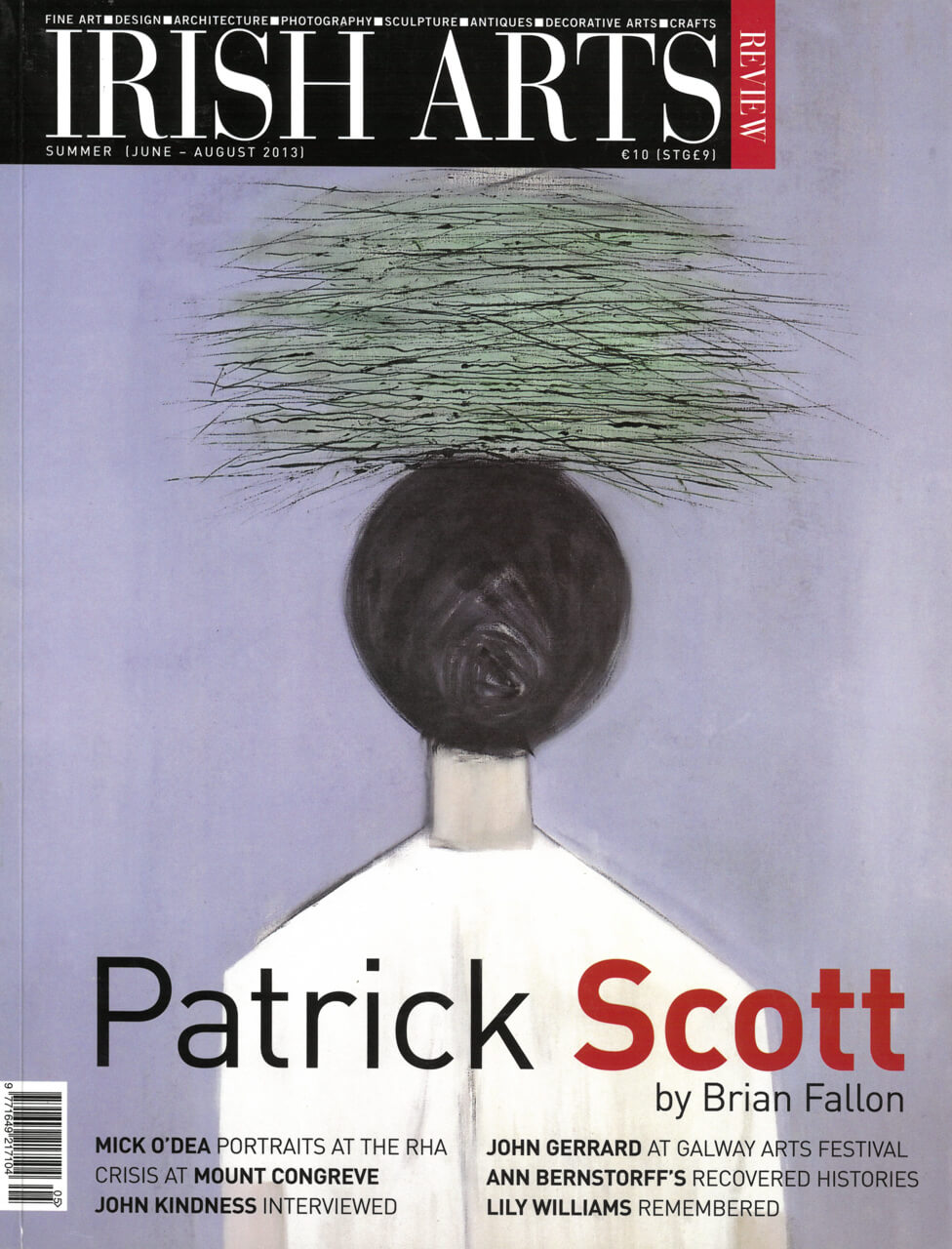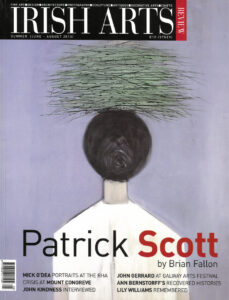

Society’s values are more happily reflected in their monuments to writers than to statesmen, suggests Gerry Walker
In most instances – Henry Moore’s monument to W B Yeats being an exception – the Irish writer is both conservatively and sparingly represented in figurative public sculpture. The genre is, like that of its political-military manifestations essentially grounded in a 19th-century classical/ naturalistic mimetic tradition. Christopher Moore’s 1857 bronze monumental portrait of the renowned balladeer Thomas Moore was reviled in Dublin as ‘that horrible exportation from London.’ Selected by a committee it reflected a burgeoning French tendency to celebrate literary achievement. It aspired to the august but never attained more than the melodramatic. It also compounded the prejudice that the Irish did not have the acumen to do the job for themselves and needed the assistance of outside agencies to complete such tasks. That resentment was to last well into the next century. John Foley’s 1864 bronze of Oliver Goldsmith (1730-1774) situated outside Trinity College Dublin (Fig 2) seems to owe its existence to the fact that he once attended lectures there as an indifferent student. It was erected on a strip of land owned by the college. Strictly speaking it would have fallen into the category of private work but since as a subject it was deemed to be uncontentious, the land was leased by Dublin corporation and the costs were met by public subscription. Goldsmith became a minor poet with a sentimental caste of mind which Foley captured with some accuracy.
In 1967, over a century later, Henry Moore (1898-1986) was finally persuaded to provide a memorial to the poet W B Yeats (1865-1939). The commissioning agency was the Irish Academy of Letters, with support from the Arts Council of Ireland. Moore had prevaricated on the proposal for quite some time, pleading fatigue from previous commission work. The bronze (one of a series of seven scattered throughout America and Europe) was eventually erected in St Stephen’s Green and was entitled Knife Edge (Fig 4). The work is an abstract/figurative synthesis and unwittingly hints at Moore’s hesitancy and reluctance to become involved in the project from the beginning. It was originally executed in 1961, flown into Ireland in 1967 and erected the same year. Formally it has nothing to connect it with the poet and as such it falls into the category of the memorial. The association with Yeats is tenuous and exists only because the selection committee and the artist have nominated it so.
The late 1960s witnessed a real development in large-scale bronze sculpture in Dublin. Edward Delaney (1930-2009), the leading proponent, produced abbreviated figures in Thomas Davis and Wolfe Tone which signalled a final stylistic and conceptual break with the previous century. Less inward-looking, despite the political subject matter, the genre was carried by a postcolonial modern European expressionism attuned to the times. Delaney had been deeply affected by the period he spent in Germany learning his craft.
These monuments attempt to answer the questions as to who and what defines us. They tend to be rooted within a shared cultural legacy and present few problems for a society with a facility and a liking for words.
John Coll’s 1991 seated bronze figure of Patrick Kavanagh (1904-1967) reflects the poet’s desire to be commemorated where there is water – canal water preferably (Fig 5). The work is a sublime expression of the naturalism that is reminiscent of Greek sculpture of the Hellenistic period where detail is both forfeited and included, downplayed and emphasized for enhanced creative impact. The traditional monumental stance has been abandoned in favour of a relaxed vernacular in keeping with Kavanagh’s persona. The poet’s trademark battered hat is placed on the bench while a rolled-up newspaper is stuffed into his jacket pocket. Coll stopped using stainless steel in favour of a more expressionistic malleable bronze. This enhanced his range of tactile possibilities and provided greater fluidity to his casting repertoire.
Danny Osborne’s 2012 mixed stone creation of Oscar Wilde (1854-1900) is located in Merrion Square, Dublin (Fig 1). It also aims for the ceremonious, but falls somewhere between the sentimental and the melodramatic. The mixed stone materials used are exotic and symbolic but in one instance poorly chosen. The head, originally composed of porcelain, showed itself to be unsuited to an outdoor work and was replaced by jade. Other materials used include thulite, granite and bronze. Wilde’s reclining figure faces two plinth-like pillars. One features a pregnant female nude and the other a male torso. Both of these structures are inscribed with selected quotations from Wilde. The symbolism is curious but may be suggestive of what was considered to be Wilde’s sexually eclectic and subversive preferences.
Rowan Gillespie’s 2000 bronze tableau entitled The Ripples of Ulysses (Fig 6) shows a life-size portrait of James Joyce (1882-1941) situated in the garden of Dublin’s Merrion Hotel. This is a duplicate version of an earlier commission from Regis University in Denver, Colorado. The brief was to create a figure to be sited on campus which reflected the embodiment of Irish literary genius. The figure stands in the centre of a series of eighteen flat bronze segments each inscribed with a passage from an episode of the eponymous book. The figurative treatment is naturalistic in style. It depicts Joyce as a detached, sophisticated, intercultural urbanite very much at the centre of modernist literary achievement.
Coupled with a demanding but highly competent level of technical execution, the overall tenor of the work is impressive and arresting. Gillespie excels technically and conceptually in his Yeats memorial sited in Sligo town and unveiled in 1990 (Fig 3). Another life-sized bronze, it reveals an unrivalled level of detail in terms of the application of textual information to the full figure. Yeats wears the embellished cloak of his genius with uncompromising ease. And yet the stance of the apparently remote aesthete does not alienate the viewer. Gillespie’s treatment does not obscure the identity of the subject unlike Henry Moore’s abstract memorial and so promotes an alliance between artwork and audience.
Irish literary monumental sculpture compared in broad cultural terms with that of the political tradition has endured and developed. The latter body of work is often viewed with detachment and in some instances downright dislike, the former with more affection. There are a number of reasons why this should be the case. In Ireland the majority of military/political monuments from the mid 19th century to the founding of the state are colonial legacies and do not invite a large measure of positive engagement with the citizenry. This changes when the struggle for independence is won and the nascent state is engaged in giving expression to its own quest for identity. It took until the mid 1960s for the link with the neo-classical, high-pedestal, rhetorical format to be discarded. Thus Kavanagh sits reflectively by the canal. Wilde reclines knowingly as his surface decoration and laconic demeanour coexist seamlessly, Yeats reads and declaims with vivacity and Joyce exudes a quiet aloofness while still managing to remain accessible.
These monuments attempt to answer the questions as to who and what defines us. They tend to be rooted within a shared cultural legacy and present few problems for a society with a facility and a liking for words. Lord Palmerston’s 19th-century didacticism still seems apposite. He suggested that portraiture could offer us no better incentive to mental exertion or good conduct than to see the features of those who have done things which are worthy of our admiration. The seanchaí has always had a special place within Irish society. And yet the power of writing has been feared as much as venerated. In the course of history the bards were feared; the poets were suppressed and the Index Librorum Prohibitorum is more than just a dim memory for many of our writers today. The writer Anthony Burgess suggested that the only index of personal value and collective power within colonial Ireland was language with its wealth of vocabulary, metaphor, imagery and music and its potential for affirming spiritual worth in the midst of material misery.
Thus today the trajectory of an evolving artform in literary monumental sculpture is characterized by an effortless juxtaposition of the grandiose, the melodramatic, the sentimental, and a joyful interplay of literary narratives. The fact that all of this is in honour of our poets elicits at least a tolerant if not affectionate response from a discerning Irish public.
Gerry Walker is a regular contributor to Irish Arts Review.
First published in the Irish Arts Review Vol 30, No 2, 2013.



